Once we made the decision to purchase our mountain home we knew that eventually, meaning real soon, we were going to need to purchase a riding mower. That or I was going to die a slow and agonizing death mowing a hilly acre + with a 22 inch self propelled lawn mower. Walking a mid sized lawnmower around for 6-7 hours once a week during the summer is a young man's game and not for me.
So once I convinced Mrs. Cog that a riding mower would improve our lives (meaning mine) and that it could be used for many other tasks, including hauling cut wood out of the woods, and all kinds of stuff around the property/garden I got down to some research.
For my price range, under $1700 if at all possible, the market is pretty narrow with only a handful of name brands available, some of which are just re-badged for that particular brand, but actually made by another manufacturer. Based upon the local mower of choice, John Deere seems to be the favorite around here with a distant second going to Craftsman. There is a smattering of Yard Boy, Cub Cadet, Snapper, Troy-Bilt, Poulan and Husqvarna.
Interestingly Husqvarna makes mowers for several of the name brands including Poulan and Craftsman. Pulling up www.consumerreports.org I found that Husqvarna and Craftsman were highly rated along with John Deere. Everyone else was bringing up the rear in the ratings at this price point with John Deere at the very high end of the price point.
As a side note, soon after moving up here in the middle of June we noticed that many people place their pride and joy lawn tractor in their front yards rather than out back in the garage or storage shed. I suspect we had stumbled upon a mine-is-bigger-than-yours informal competition amongst the locals. I wisely decided not to show mine being new to the neighborhood. Besides, we live at the end of a dirt road off a dirt road off a back road so no one would see it anyway. :)
My qualifications were simple. I wanted power for the hills on the property and nothing wider than a 46" cutting deck because of some tight spots to get through and a generally uneven and bumpy lawn. I wanted four control wheels for the cutting deck to help prevent scalping the uneven lawn, and as much as I wanted to go with the manual transmission, since Mrs. Cog and daughter were going to use the tractor at times, I decided to go with an automatic transmission.
Because the John Deere was several hundred dollars about my ideal price range and the nearest Husky dealer was 50 miles away I decided to go with the Craftsman....which was essentially the Husky except for some trim pieces and badges. Best of all it was on sale and shipping was free from the local Sears outlet within 25 miles. Plus I could get service from there as well. The 2 year warranty on the mower and 5 years on the frame was also as good or slightly better than the Husky.
So I took the plunge and purchased the Craftsman YT 4000 46 inch 24 HP Riding Lawn Tractor Model 28857 for just under $1,630 plus tax. Above are pictures of the tractor on delivery day with lots of bright promise and no disappointment yet realized. Houston, the baby has landed.
To be honest I was a bit intrigued by the Briggs & Stratton 724 cc 24 HP V-Twin OHV motor, particularly the fact that the lubrication system was pressure fed rather than the typical splash oiling system. Briggs only makes one mower engine larger than this in this line, a 26 HP slightly larger displacement engine that was much more expensive. And Consumer Reports rated this tractor a Best Buy, so why not.
The 46 inch cutting deck uses two blades rather than three. Which means there is a slightly higher tip speed on these longer blades and I was hoping this would help cut my less than the best lawn. As it turns out the deck does a real nice job cutting the uneven lawn mainly because of the four control wheels, two more than most decks. However, I did find every damn rock in my yard by the end of the cutting season, so we can kiss that set of blades goodbye. I will re-sharpen them as best as I can and then put them aside as backups.
BTW as ineffective as the wash out plug/nipple was on the self propelled Husky lawn mower, the one on this deck worked brilliantly. Anyone who owns a large cutting deck knows how difficult it is to properly clean out all the grass clippings after each use, particularly in the spring when the grass is very green and sticky. Yet 5 minutes with the hose attached to the clean out nipple and the underside of the cutting deck is super clean.
The picture below was taken when I finally pulled the deck off the tractor at the end of the cutting season. That was the condition I found it in when I turned it over. Remarkable really. But check out the damage to the cutting blades. Damn to hell those rocks.
There were some nasty comments about the B&S V-Twins left on the various internet blogs, but it seems they were talking about an older version of this engine and some of them don't understand that the oil level must be maintained and the oil changed more often than every ten years. The two year warranty on the engine put to rest any fears I had on this one. I knew I would be careful and maintain it per the schedule so if it was going to break, it will probably break during the warranty........hopefully.
During the winter months I'm using the tractor as a work horse, hauling the swivel dump cart around the woods and on the the local (abandoned) logging roads while cutting wood for the Heatmaster 5000. As long as I can get traction the tractor will go anywhere I want it to and some of these logging roads are very steep. I put chains on the rear wheels to help with the traction issues and with my 280lbs seated over the rear axle, as long as both wheels get a bite there is no stopping this beast.
The other day I descended this (see below) steep 20 year old logging road I had previously cleared to get to some fallen trees I had already bucked some months ago. I had previously abandoned the wood because it had rained and I could not get enough traction to pull the loads back up the incline. Since it had been dry for a week I tried again, rightly assuming I could deal with the leaves, loose soil and rocks and make it back up for the two trips needed to get all the wood out.
Both trips were still an adventure and the last 30 feet were interesting as I shifted my weight back as far as I could to maintain traction. I actually got the front wheels off the ground for a good distance. It reminded me of my youth crashing around in the woods on my dirt bike. The hill is actually steeper than it looks in the photo. Clearly traction and not power is the limiting factor with this tractor.
Craftsman touts their so-called "Turn Tight Technology" on many of their tractors. While I like that the tractor will turn tighter than most other tractors and close to the turning capabilities of a zero-turn mower there are times when it is a pain.
For example, on any wet or slippery surface if you wheel the tractor to one side or another too quickly the front wheels start to plow instead of grab and change the direction of the tractor. This can be as minor as sliding on the lawn a bit to as major as running off the logging roads around here.
I suspect I'm asking this tractor to do things not normally asked of it nor designed to do it. I am learning to compensate for it by being a bit more careful when turning, particularly on a down slope. I suspect the larger than average amount of power available also has something to do with it. No other 46" cutting deck mower out there came with a 24 HP engine. This power rating is usually reserved for 48' - 56" cutting decks. In fact Sears no longer sells this combination of engine size, power and cutting deck size.
The Hydrostatic Transmission has been flawless, handling anything and everything I throw at it. At times I wish I had a lower pulling gear, but have developed a workaround by lowering the engine speed and engaging the drive, then after fully engaged slowly increasing engine speed. This helps cut down on wheel spin in low traction conditions. It works because the engine seems to have plenty of low end torque and doesn't need to be revved in order to pull a heavy load from a standing (uphill) start.
The cutting deck has 6 positions, thought in practice I stick with one or two because of the lumpy bumpy lawn. And the cutting deck height adjustment is spring loaded, which helps take the work out of raising the deck momentarily when abruptly changing grades or running over high spots and bumps.
The four control or "gauge" wheels on the cutting deck are adjustable and the drill is to find the average deck height you will be using, then adjust the wheels to that height. I was definitely spot on in requiring 4 wheels because 2 would have been a disaster. On the other side of the equation, those 4 wheels tend to discourage turning the tractor and may contribute to the tendency of the mower to continue straight when turned sharply on slippery grass.
The cutting deck was pretty easy to remove, requiring for the most part removal of clips and pins and the removal of the drive belt from the main engine pulley without having to take it off the deck. The two plastic guards placed over the pulleys directly driving the cutting blades are poorly designed and tend to trap grass and debris that doesn't come out easy when cleaning. But don't pull off the guards because soon enough you might be missing a toe or finger.
The seat is surprisingly comfortable, not too soft and not too firm for a big guy like me and adjusts forward and backward at least 6 inches, allowing short Mrs. Cog and tall Mr. Cog equal access to the joys of lawn mowing nirvana. Best of all it is sealed so you can spray away with the hose and not worry about a water logged seat.
The gas tank is located under the seat, my preferred location, rather than up under the engine cowling shoehorned in next to the battery. It holds at least 3 gallons and won't run out until I have been worn down from the work. The seat folds up to get to the bolts under the seat and to access the top of the gas tank. There is a "gas gauge" down between your legs that is useless and not worth even looking at. The actual gas tank filler spout is to back left when seated on the tractor and it has a large open mouth and is easy to fill. The cap clicks when fully screwed on.
The engine has a fuel filter to the left of the engine that is easy to access when it needs to be changed. The oil filter is bright yellow and on the same side as the fuel filter which feeds into the fuel pump. The air filter is a two stage filter system and is easily reached up top with two finger sized 'bolts' that screw off and on by hand. The battery is snugged up behind the engine and under the control panel/steering wheel.
If you scroll further up and look at the image of the right side of the engine you will find the engine oil dip stick with the yellow cap and a rubber hose with a yellow cap. That hose is the oil drain hose and it has a positive lock cap for no unexpected surprise oil dumps. This makes changing the oil a breeze, though changing the oil filter on the other side can and does get messy. Two quarts of the good stuff please and check the tires as well.
The 'break' pedal is to the left and the 'go' pedal is to the right. They are large pedals and that's good for those of us who wear large heavy work boots. Never have I pushed on either pedal and felt any bend or spongy feel. 'Reverse" is this little nub sticking up through the floor board on the right. I suppose it is designed this way to make you consciously search for it so that you are mindful of what you are doing. I find it a pain in the butt.
The ignition switch must be turned to the 'reverse' position when the cutting deck is engaged before backing up or the engine stalls. Just another safety feature to prevent mindless backing over of pets and children.
There is something they called a parking brake. Basically you depress the brake and then pull up on a lever below and to the left of the steering wheel and it keeps the brake engaged. Do this after disengaging the cutting deck and you can get off the seat without stalling the engine. Don't set the parking break and as soon as you stand up the engine goes out. Safety first. The nanny state loves you.
There is also a cruise control which doesn't actually change engine speed, but basically locks the "go" pedal in the down "go" position. Hit the brake and it disengages. And what tractor is complete without a cup holder on the back right side. I laugh at it, then put my water bottle in there and am grateful for the holder when I have worked up a thirst.
At over 500 lbs this is considered a mid size tractor. I have grown fond of it and I'm often impressed with what it can do once you know how to work around its quirks. While we have yet to see how reliable it is, with over 50 hours on it so far all is well. I will post updates as the new cutting season progresses.
01-30-2014
Cognitive Dissonance
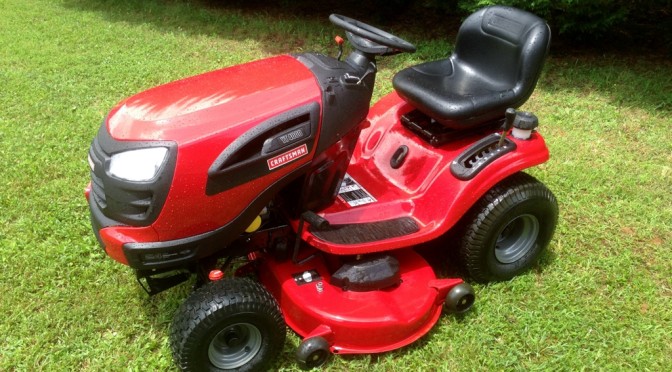
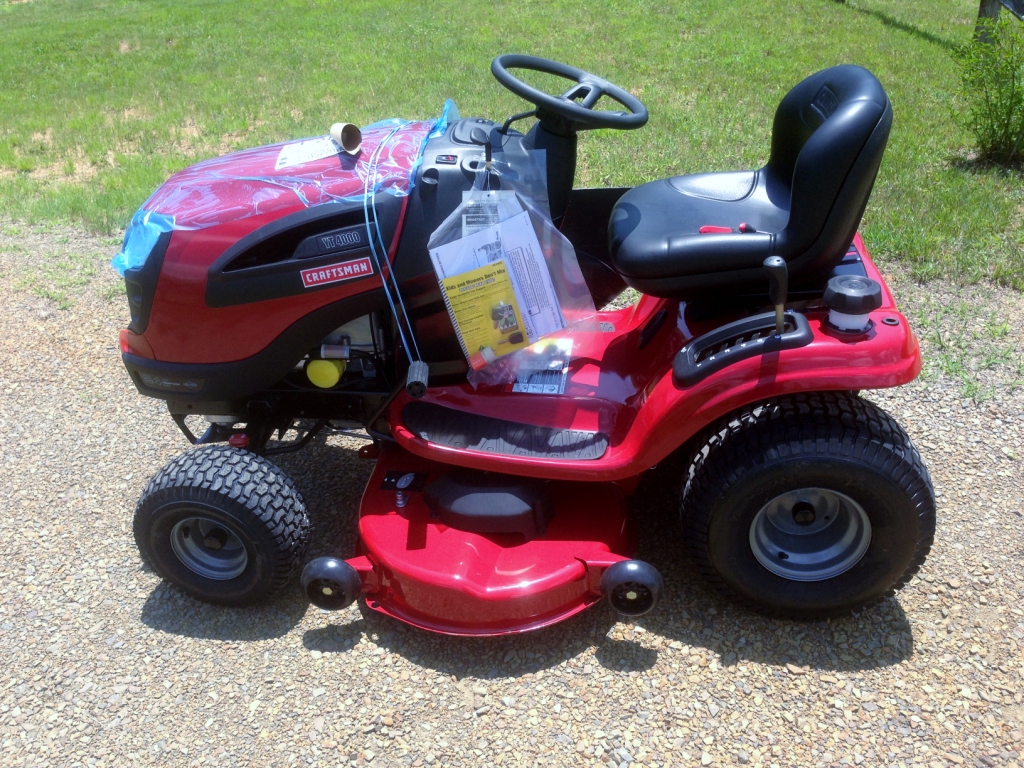
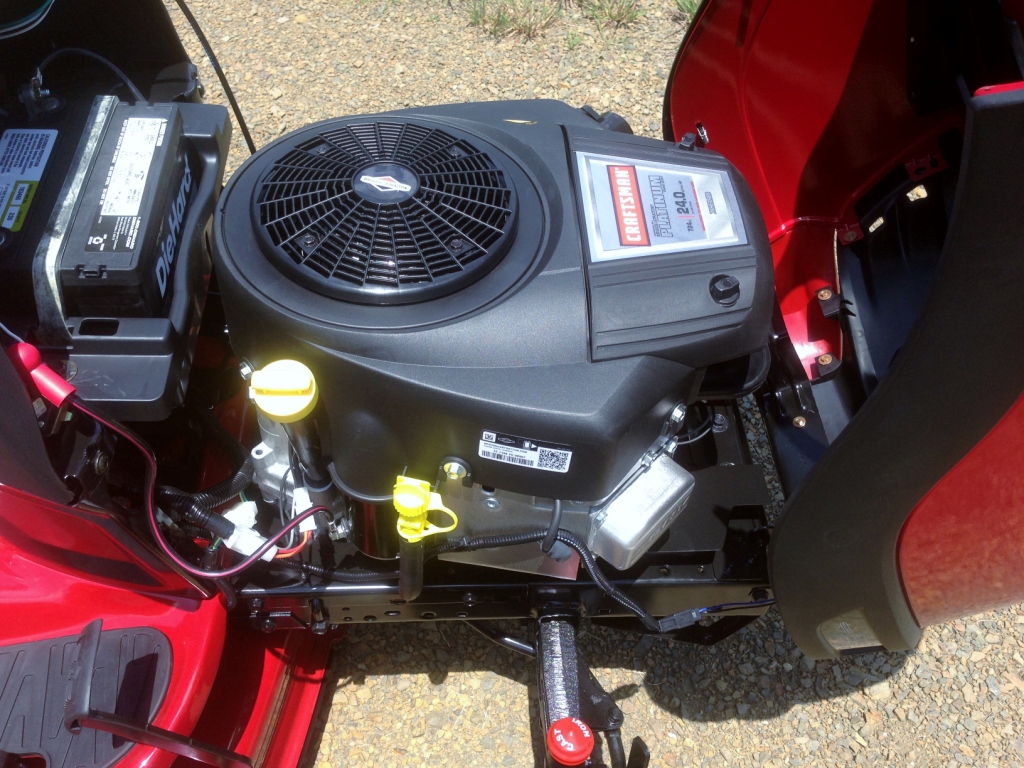
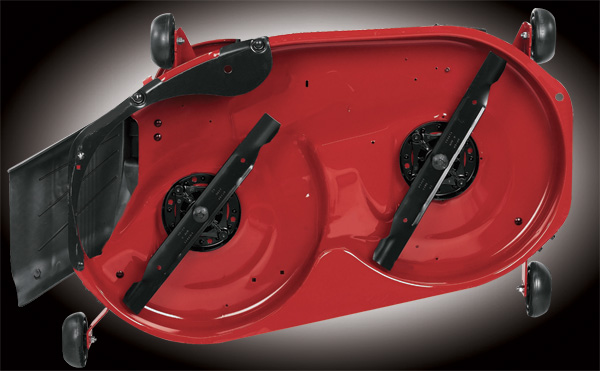
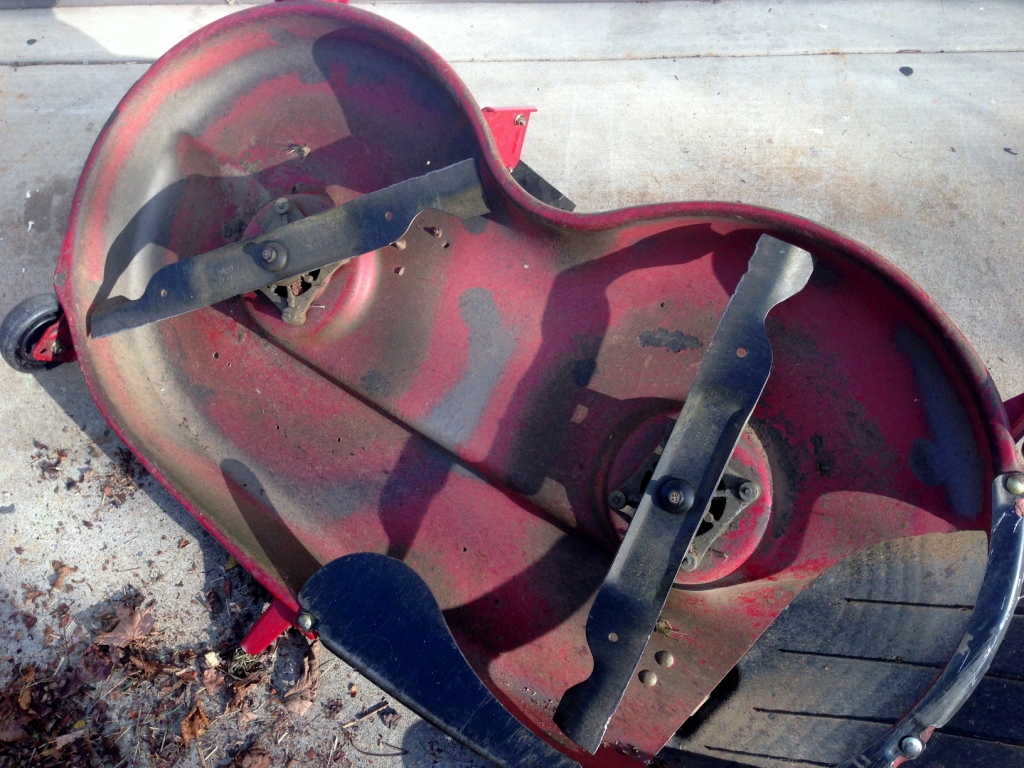
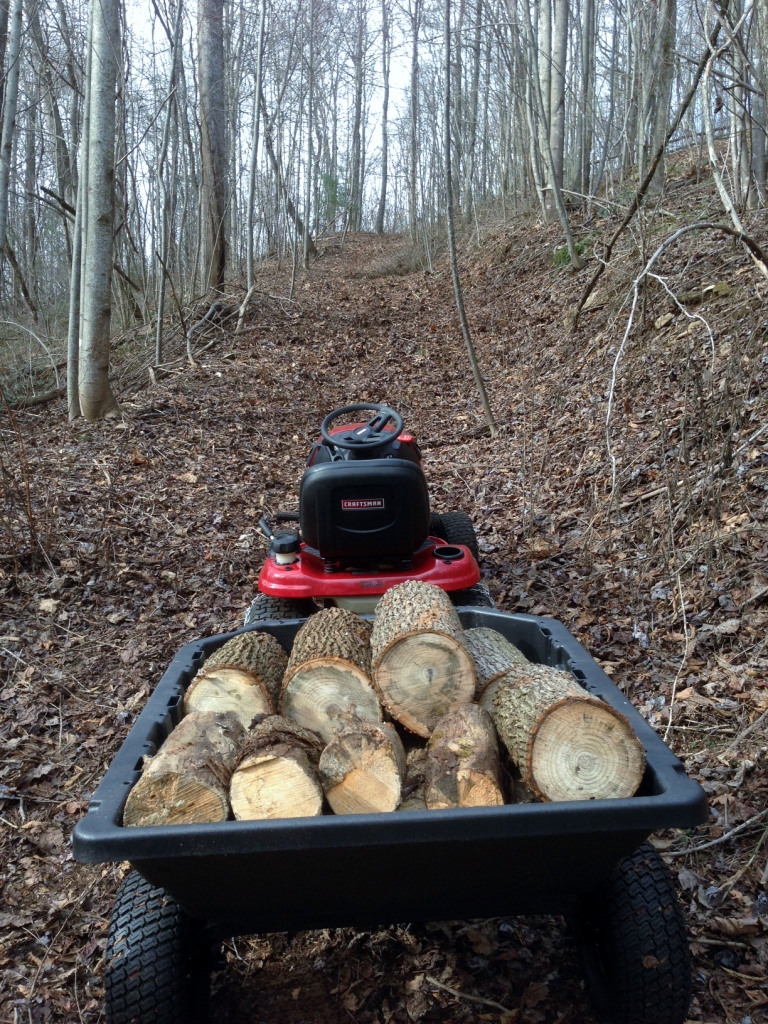
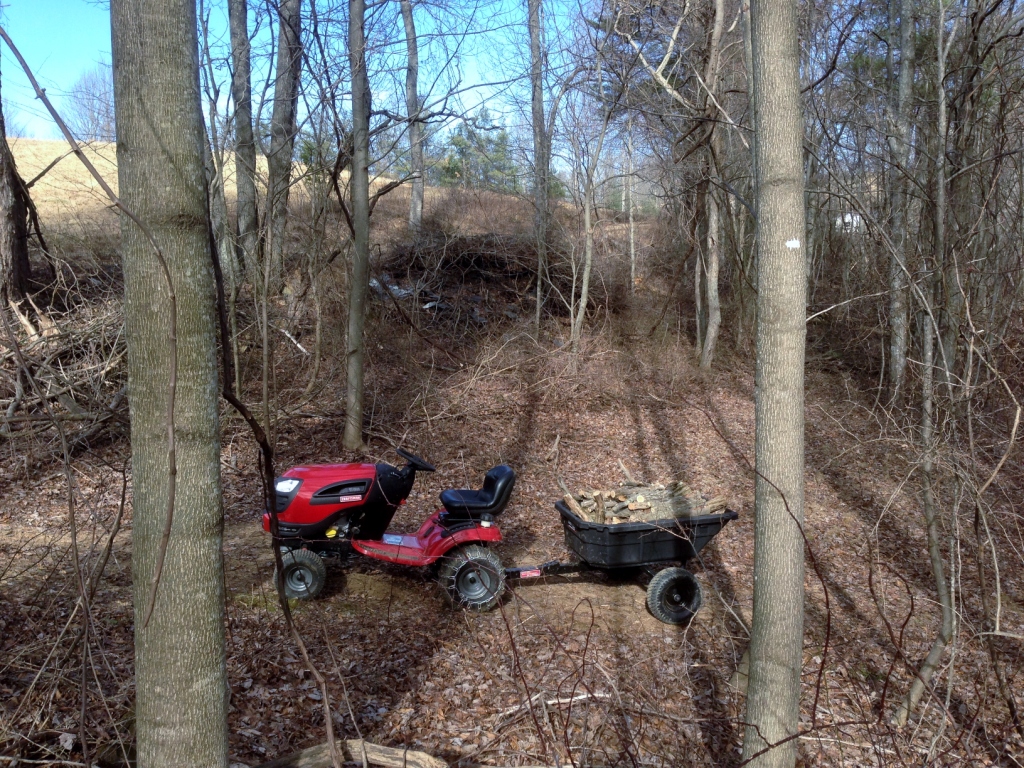

You NEVER let me drive the pretty red tractor!
Wheel weights and or a weight box might solve your traction problems. If you can get wheel weights for your model those would attach to the bolts holding on the rear wheels (they probably would give you longer bolts to go both through the weights and the wheel).
The other option I have on a Cub Cadet (in need of repair). There is a bracket that goes on the back of the tractor and does not impede the use of trailers. Once the bracket is on you can get weights that hang on the bracket and slide them out so they sit on the bracket behind the wheels. This option does help with traction and if one weight behind each wheel is not enough you can get more weights to hang on the bracket. This link shows you the parts that would make up a Cub Cadet version of what I am trying to describe.
http://www.cubcadet.com/equipment/cubcadet/lawn-and-garden-tractors/series-1000/490-900-m060
I have looked into wheel weights for the Craftsman and I am considering purchasing them. However the real problem is that I am using a residential grade tractor on some pretty steep terrain. Not sure if anything other than tire chains, which I have on now, will help.
Considering what I paid for it and how much I have used it over the winter to haul lots of fire wood up and down these old logging roads I am quite impressed. Headed into year two cutting season. so the real test begins. I need to do some maintenance on it before cutting seasons beings in a few weeks. I have new blades for the deck, need to grease some fittings, oil was recently changed, want to sand and prime some tiny rust spots before they get bigger and so on.
Cognitive Dissonance